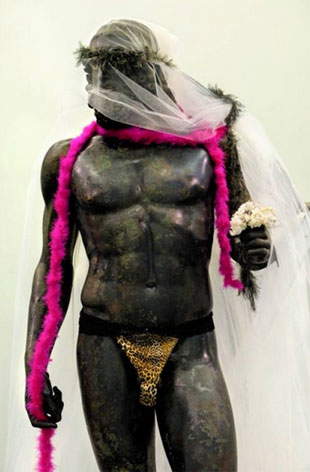July 28 was Marcel Duchamp’s birthday: he was the first artist to revisit a masterpiece of the past in a desecrating way to denounce thehypocrisy of contemporary society. It was 1919, Duchamp’s work was L.H.O.O.Q., his gesture scandalized the well-wishers of the time and still continues to cause discussion today. Less of a stir, on the other hand, was the work of Andy Warhol’s former collaborator, photographer Gerald Bruneau, who, as we learn from an article in Dagospia (where you can also see a gallery with photographs), “tricked his way” into the National Archaeological Museum of Reggio Calabria and adorned the Riace bronzes with leopard-print thongs, bridal veils, and shocking pink boas.
The intent of the operation? It is Dagospia that tells us:"to unmask prejudices and hypocrisies," obviously about homosexuality. Meanwhile, we can safely say that, if one of the purposes was to shock observers, Bruneau has failed in his intent: apart from Dagospia, a handful of art communication magazines, and a few local newspapers, no one has given any weight to the affair. Which can only mean one thing: the public, from 1919 to the present, has matured and assimilated this way of proceeding. Provocation as an art form has grown weary by now, and there are basically two ways in which it still manages to get people talking about itself: when it touches on issues about which public opinion is strongly sensitive (such as the love of animals, for example: the provocation of Hirst’s sheep in Arezzo proves it) or when there is a performer or, better yet, a performer, who strips off completely and walks around without anything on (as Milo Moiré did recently in Basel). Not to mention the fact that it was Duchamp himself who founded the assumption that the artist is recognized by theoriginality of the idea. So: given that Gerald Bruneau’s performance is unoriginal (as we have seen, it has been ninety-five years since, for the first time, a masterpiece of the past was desecrated) and scandalizes no one, why do we feel the need to talk about it?
 |
| Gerald Bruneau’s performance. Photo taken from Dagospia |
For a very simple reason: because it is a performance that creates more harm than good. Because if, as Dagospia says, it is a “provocation pertaining to the issues of the present: rights, sexuality, gender, discrimination,” then Bruneau is merely trivializing years of struggle for equal rights, for gender equality, against discrimination, by presenting us with the most grim and insulting stereotype of the homosexual, that of the effeminate gay man with a leopard print thong by order and a boa around his neck. Those who really care about the fate of the homosexual world know that homosexuals are not really so happy to be represented in this way: the effeminate gay man with the boa, speaking of stereotypes, is the equivalent of the Italian with pizza and mandolin. In homosexual circles there has long been criticism of this way in which gays are represented and, in a certain respect, ridiculed: that is why such operations do not raise anyone’s awareness of the problem but, on the contrary, risk increasing prejudice against homosexuals. And we know how harmful prejudice is: just remember recent news events.
The fight against discrimination andhomophobia does not pass through slogans or images of dubious taste and dubious usefulness, or through provocations that do not provoke or make people think. The fight against discrimination passes througheducation andteaching, and the first teaching should be one that explains to society that there is no such thing as different when it comes to homosexuality: there is a person who is identical to us, who only has different tastes in sexual matters. So how can we get the message across that homosexuals are identical to us if we represent them with boas and leopard-print loincloths? Why does a homosexual have to be effeminate? Why feed this idea into the minds of those who do not know homosexuals well?
So let’s start thinking about serious campaigns, perhaps involving schools as well. There are several aspects to think about. The fact that homosexuality is not a deviance but is a normal expression of human sexuality. The fact that homosexuals deserve the same, identical respect as heterosexuals. The fact that homosexuals should enjoy the same civil rights as heterosexuals. And, of course, the fact that proper sex education, both homo and hetero, is appropriate. But, please, let us avoid stereotypes: with these, we go nowhere.
Warning: the translation into English of the original Italian article was created using automatic tools. We undertake to review all articles, but we do not guarantee the total absence of inaccuracies in the translation due to the program. You can find the original by clicking on the ITA button. If you find any mistake,please contact us.